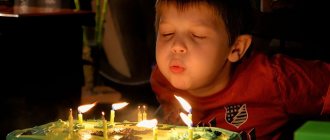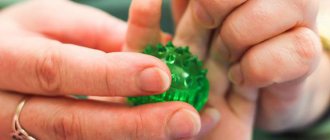Nasal breathing.
It is imperative to breathe through your nose; the habit of breathing through your mouth has a very harmful effect on human health. Yogis believe that breathing through the mouth is as unnatural as eating through the nose. They claim that children who breathe through their mouths are retarded in their mental development. Nasal breathing protects the throat and lungs from cold air and dust, ventilates the lungs and middle ear cavity well, and has a beneficial effect on the blood vessels of the brain. In addition, such gymnastics significantly increases the strength of the protective mechanisms that protect the brain from insufficient blood supply. It is necessary to breathe through the nose both in everyday life and when performing breathing exercises.
The purpose of these exercises: the child should learn to feel the difference in the direction of the air stream.
Forming smooth exhalations through the nose or mouth and alternating them.
Exercises:
- open your mouth wide and breathe calmly through your nose;
- close one nostril with your finger - exhale smoothly and inhale through the free nostril. Alternately close the left and then the right;
- inhale through slightly closed lips, exhale smoothly through the nose;
- inhale with your mouth wide open, exhale smoothly through your nose (do not close your mouth);
- inhale through the nose, exhale smoothly through the mouth (mouth wide open, tongue on the lower teeth - like warming your hands);
- inhale through your nose, exhale smoothly through loosely closed lips;
- inhale through the nose, exhale smoothly through the corners of the mouth, first through the right, then through the left.
Formation of jerky exhalations through the nose or mouth and their alternations.
Exercises:
- inhale through the nose, exhale through the nose in bursts;
- inhale through the nose, exhale through loosely closed lips jerkily, intermittently, taking short intervals;
- the mouth is wide open, stick out the tongue, inhale and exhale through the mouth jerkily, intermittently (like a dog breathing);
- inhale with your mouth wide open, exhale jerkily through your nose (do not close your mouth);
- inhale through the nose, exhale jerkily through the corners of the mouth, first through the right, then through the left.
Formation of the ability to combine smooth and jerky exhalations.
Exercises:
- inhale through the nose, elongated exhalation with intensification at the end;
- inhale through the nose, jerky exhalation, at the end turning into a smooth exhalation;
- the lips are extended forward like a tube. Inhale through the nose, exhale jerkily through the mouth, finally turning into a smooth exhalation;
- inhale through slightly closed lips, elongated exhale through the nose with intensification at the end;
- inhale through slightly closed lips, jerky exhalation also through the mouth, at the end turning into a smooth exhalation;
- lips in a smile, inhale through the nose, elongated exhale through the mouth;
- lips in a smile, inhale through the nose, jerky exhale through the mouth, at the end turning into a smooth exhalation.
Each exercise is performed 8 times, after a 3-5 second break it is recommended to move on to the next one. The total duration of gymnastics is 5-6 minutes.
Correct speech breathing - how it should be:
- Active inhalation is performed exclusively through the nose.
- Exhalation should occur through the mouth, long, evenly, without jolts or pauses.
Sometimes children exhale through their nose. Try simply closing the nasal passages with your fingers so that the child understands what is required of him. Explain that the lips should not be pursed or tense when exhaling. They need to be pulled out with a “tube”.
For self-control during classes, ask the child to place his palm between the ribs and stomach (diaphragm). During inhalation, the front wall of the abdomen and chest rise slightly, as if “moving away” from under the palm, and as you exhale, they fall, returning to their original place.
The difference between speech breathing and physiological breathing
There are two types of breathing:
- physiological (inhalation and exhalation: approximately the same time). The main task of such breathing is to carry out gas exchange.
- speech (short inhalation - pause - long sound exhalation). The main task here is sound production, ensuring intonation expressiveness, fluency of speech, and observing pauses between sentences.
All sounds are formed on exhalation, so the formation of speech breathing is one of the important factors in the development of speech.
When pronouncing the vast majority of sounds of the Russian language, a strong, directed air stream is required. The process of exhalation is of enormous importance, because it is at this moment that speech begins to sound: sounds, syllables, words, sentences.
MAGAZINE Preschooler.RF
Development of speech breathing in preschoolersBreathing is one of the life support functions of humans. The development of speech breathing plays a big role in the development of correct speech, because The source of the formation of speech sounds is an air stream leaving the lungs through the larynx, pharynx, oral cavity or nose to the outside. Correct speech breathing ensures normal sound production, creates conditions for maintaining normal speech volume, strictly observing pauses, maintaining fluency of speech and intonation expressiveness.
Speech breathing differs from non-speech (physiological breathing) in that during speech, after inhalation, which is carried out simultaneously through the nose and mouth, there is a pause. Speech breathing is carried out voluntarily, non-speech breathing is automatic. During the process, speech exhalation occurs mainly through the mouth, it is somewhat slower. During physiological breathing, inhalation and exhalation occur only through the nose. They are approximately the same in duration.
Correct speech breathing ensures: normal functioning of the vocal apparatus, protects the vocal apparatus from overfatigue, helps maintain fluency of speech, promotes the correct use of intonation means of expression, and promotes the correct observance of pauses.
Speech breathing can be difficult due to chronic runny nose, adenoid growths, general weakness of the body, and some cardiovascular diseases.
Improper speech breathing is often the cause of impaired fluency of speech (speech while inhaling), late or incorrect assimilation of certain sounds, weakening of the voice volume, especially at the end of the pronunciation of long phrases, in some cases, acceleration of the tempo of speech, incorrect use of intonation means of expression, unclear pronunciation of words (swallowing endings).
For full speech breathing, flexibility, elasticity, and a large volume of the respiratory apparatus are required, which is achieved by training the speech and vocal apparatus (pronouncing individual sounds, syllables, words and phrases), combined with appropriate movements.
Breathing exercises correct speech breathing disorders, help develop diaphragmatic breathing, as well as the duration, strength and correct distribution of exhalation. Performing breathing exercises helps maintain and strengthen the child’s health. It makes it possible to recharge with vigor and cheerfulness, and maintain high performance. Gymnastics is well remembered and after training it is performed easily and freely. In addition, breathing exercises have a complex therapeutic effect on the human body. Breathing exercises develop long, uniform exhalation in children and form a strong air stream through the mouth. By evoking positive emotions, such exercises increase the child’s interest in breathing exercises, which also contribute to the development of creative imagination and fantasy.
Requirements for performing the exercises:
- Before starting the exercises, it is necessary to ventilate the room: the air in the room should be of medium humidity
- clothes should not restrict movement
- It is not recommended to perform speech exercises after eating
- exercises are performed sitting, standing or lying down
- it is necessary to control the teacher over the correct execution of the exercises (make sure that children do not raise their shoulders, but also that they do not “over-breath.” “Over-breathing” entails a sharp exhalation - the voice sounds intermittent, forced. Therefore, the amount of exhaled air should not be too large. You also need to avoid long breath-holds. At the same time, children must be explained why they need to learn to breathe harmoniously - with a full breath, speak only as you exhale, do not draw in air while pronouncing a word, and take meaningful pauses when pronouncing phrases)
- exercises must be limited in time: from 30 seconds to 1.5 minutes (an hourglass can be used), because they quickly tire the child and can even cause dizziness
- be sure to alternate the exercises with other exercises
- It is better to practice when the child’s emotional state is balanced and the child is not tired.
Each exercise is practiced as many times as necessary for all children in the group to perform it accurately.
Exercises should be carried out:
- during physical education and recreational gymnastics
- during classes, including them at an organizing moment or during physical exercises
- after a nap
- in the free activities of children.
The teacher’s task is to teach children how to use speech breathing correctly. To do this, it is necessary to carry out preparatory work already at the early stages of speech development (in the younger groups of kindergarten), the essence of which is to teach children to take a short breath, without straining the muscles of the face and neck, and exhale smoothly and silently through the mouth, producing sufficient air force .
When starting to develop speech breathing in a child, it is necessary, first of all, to form a strong, smooth oral exhalation. At the same time, it is necessary to teach the child to control the exhalation time and use air sparingly. Additionally, the child develops the ability to direct the air stream in the desired direction.
The parameters of correct oral exhalation are:
- exhalation is preceded by a strong inhalation through the nose - “we take a full chest of air” ;
- exhalation occurs smoothly, and not in jerks;
- during exhalation, the lips form a tube; you should not purse your lips or puff out your cheeks;
- during exhalation, the air comes out through the mouth, you should not allow the air to exit through the nose; if the child exhales through the nose, you can pinch his nostrils so that he feels how the air should come out);
- you should exhale until the air runs out;
- While singing or talking, you should not take in air with frequent short breaths.
Game exercises for breathing development
Cutting wood. Children stand opposite each other in pairs, hold hands and imitate sawing wood: hands toward you - inhale, hands away from you - exhale.
Warm up in the cold. Children inhale through their nose and blow on their “chilled” hands, exhaling smoothly through their mouth, as if warming their hands.
We inflate the toy. Children are invited to inflate rubber inflatable toys, balloons, taking in air through their nose and slowly exhaling it into the hole of the toy.
The leaves are rustling. They offer strips of thin green paper, cut into leaf shapes and attached to . ” At the signal “A breeze has blown,” children gently blow on the leaves so that they rustle .
Butterflies. “Green glades” (flowers, tree leaves) with colorful butterflies (and other insects) cut out of thin paper are laid out in front of the children Butterflies are attached with thin threads to the “clearing” . You can only blow on a butterfly with one exhalation. At the signal “The red butterfly has flown,” children blow on red butterflies, etc.
Blow out the candle. Children have candles cut out of paper. The flame is made of thin paper or satin ribbon. At the signal “Breeze”, children slowly exhale so that the “flame” of the candle is deflected.
Roll your pencil. Children are asked to inhale through their nose and, exhaling through their mouth, roll a round pencil across the desk.
Bonfire. A mock-up of a fire with strips of thin red paper is placed in front of the children. Children are encouraged to fan the dying fire by inhaling through their nose and exhaling slowly through their mouth.
Cool the tea in the cup. Each child has a cup cut out of colored cardboard. Strips are attached from thin paper or satin ribbon - “steam” . Children are invited to cool the tea in a cup.
Snowflakes are flying. Light pieces of cotton wool or snowflakes cut out of thin paper are attached to the strings. Children are asked to blow on them for a long time using the signal “Snowflakes are flying .
Pinwheel. Children are asked to blow on the pinwheel for a long time so that it spins smoothly.
Ball. The teacher invites the children to blow on a light ping-pong ball, which is in a bowl of water.
Feather. Children blow a feather from their palm, a light cotton ball from their palms.
Curtain. Make houses with a window out of cardboard, with a curtain on the window (strips of thin paper or light fabric); a set of small toys (toys from Kinder Surprise , photographs, surprise) located behind the Curtain . The teacher encourages the children to find out what is behind the “curtain” in each house.
Breeze. The teacher invites children to blow on a dandelion flower, a twig with leaves, or on leaves cut out of tissue paper, like a breeze, accompanying the actions with a poetic text:
It's a very hot day. Blow, blow, our little breeze. Breeze, breeze, Blow - blow, our breeze.
Ship. The teacher invites the children to blow on a light paper or plastic boat in a basin of water.
Bubbles. This is done using a glass half filled with water and a cocktail straw. The teacher shows the children how to blow bubbles using a straw (inhale through your nose, exhale through your mouth, holding the straw between your lips).
Droplet. Take cocktail straws, watercolor paints, sheets of paper. The teacher drips paint onto a sheet of paper and invites the children to blow on it through a straw, the droplet “runs” and leaves a mark behind it.
Literature
- Belyakova L.I., Goncharova N.N., Shishkova T.G. Methods for the development of speech breathing in preschoolers with speech disorders. - M.: Publishing house LLC "Knigolyub" , 2005.
- Guskova A.A. Development of speech breathing in children 3-7 years old. - M.: Publishing house "Sfera" , 2011.
- Epifanova O.V. Speech therapy. Development of activities for preschool children. Issue 1. - Volgograd: Publishing house "Teacher-AST" , 2004.
- Leonova S.V. Game library of speech games. Issue 12. Live pictures. Games for the development of speech exhalation in children 5-7 years old with speech disorders. – M.: Publishing house “Gnome” , 2011.
| Next > |
Games and exercises to develop speech breathing
There are many games for developing speech breathing.
- Blowing out a candle. Children are asked to blow out the candle. You can give various settings, for example, show how the breeze blows. The wind blew softly, but now it blew strongly. (monitor the safety of the game being played).
- Who was hiding behind the grass? Colored green paper (this is grass) is cut into strips. Cards with images of animals are placed one by one under the “grass”. The child is asked to blow on the “grass” to find out who is hiding there.
- Games on musical instruments (pipes, harmonica, whistles).
- Windmill. Invite your child to blow on the pinwheel.
- Bubbles. For this game you will need a container of water and a cocktail straw. You can add food coloring or bubble solution to the water, but you must be sure that your child will not swallow this liquid. Therefore, it is initially recommended to practice the game in clean drinking water.
- Sorting items. To play you will need two plates, pieces of colored paper of matching colors, and a straw. The child must use a straw (inhale air) to move the paper to the desired plate.
- Blowing away cotton wool or a feather from the table.
- Sail the ship. Place paper boats in the water and invite the child to blow on them.
- Airball. The principle is similar when playing the pipe. Children blow into a tube in order to lift and hold a foam (light) ball above it.
- Get the ball into the goal. The goal is to drive the ball into the goal using breathing.
- Bubble. One of the most favorite games among children.
- Encourage your child to blow on the food to cool it down before each meal.
- Ask to show how the wind blows (uuuuuuuuuuuuuu), a bee buzzes (zhzhzhzhzhzhzh).
Games and competitions for speech development
When the child has learned to breathe correctly, you need to associate slow exhalation with speech. During the first lessons, the baby can sing vowel sounds. First, he takes a deep breath, and as he exhales, he hums: “Ah-ah-ah” or “Ooo-oo-oo-oo.” Try to keep the singing at the same tempo and key throughout. If the child constantly gets louder and quieter; then higher, then lower, record it on a voice recorder and explain its mistakes. Don’t turn into a strict teacher, make comments good-naturedly, with humor: “Listen, how you started cheerfully and cheerfully, but ended completely sad, it looks like something sad happened in the song.” When the sound is smooth, learn to sing with rising and falling pitches.
Advice
Older children can be told what vocalization is and given recordings to listen to. Invite them to also try changing the key to create a melodic tune.
Start with small words, repeating them several times. Show your child pictures or toy animals, and he should, with one exhalation, depict 2-3 times what sounds they make: “Woof-woof-woof,” “Meow-meow-meow,” “Ko-ko-ko.” Act out scenes that your child will voice. A bear is walking through the forest “Top-top-top”, he saw a little house, knocked “Knock-knock-knock”. Remind that before saying anything, the baby must take a full lungful of air.
Short nursery rhymes, for example “Toys” by A. Barto, will be a good training for proper speech breathing during conversation. For each exhalation you need to say one line, then inhale - and the next line. Games for developing proper breathing in a child can be included in morning exercises. Add several exercises to the complex, repeating each 4-6 times:
- "Clock with a pendulum." Starting position: feet shoulder-width apart, hands raised, fingers clasped above the head. Inhale, as you exhale, bend to the side and make a long sound “Bomm”. Repeat on the other side.
- "Let's go for a ride in the car." Starting position: stand straight, arms extended forward, fists clenched. After inhaling and exhaling, the child turns the imaginary steering wheel to the right and makes a sound that imitates the operation of a motor. Repeat several times in different directions.
- "The ball burst." While inhaling, the child spreads his arms to the sides, while exhaling, brings them together in front of him, as if hitting a balloon, and says “Clap.”
- "Battleship". Launch paper boats into a bowl of water. By alternately blowing on one or the other, the baby can play both pirates and sea battle.
- "Air Tennis" This game requires 2 participants. Draw a strip in the middle of the table and place a table tennis ball on it. On command, both children blow on the ball, whoever drives it to the opponent’s side wins.
- "Mother duck is looking for ducklings." Throw a few floating ducks into the basin and say that the kids are lost, the mother must find them. Using a stream of air, you need to direct the largest toy to search and collect all the figures together.
Tips for doing breathing exercises
- Time limit up to 5 minutes. Breathing exercises have a fairly large load on the body of children. If you overdo it, you may feel dizzy and have a headache.
- Regularity. Breathing games are recommended every day.
- The room in which the child studies must be ventilated.
- Pay attention to how the child performs the exercise: the shoulders should not rise during inhalation, and the cheeks should not puff out during exhalation. The exhalation should be calm, smooth, unhurried.
- If the child is unable to exhale through his mouth, gently pinch his nose.
- Breathing exercises should be varied to interest the baby. Don't repeat the same task over and over again.
- Consider the child's age.
- Safety of games and exercises. If this is a “Blow out the Candle” game, then keep track of the safe distance. Do not be distracted by extraneous factors, concentrate only on the child.







